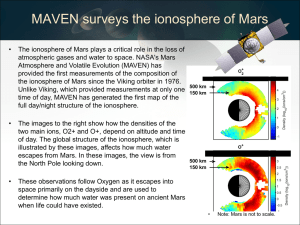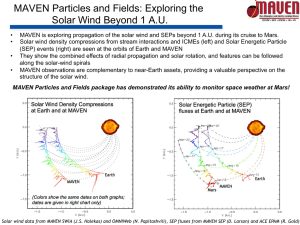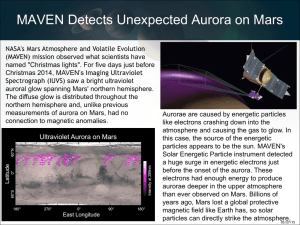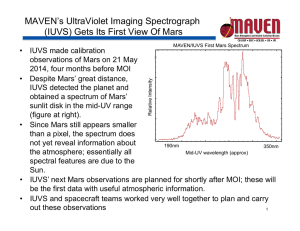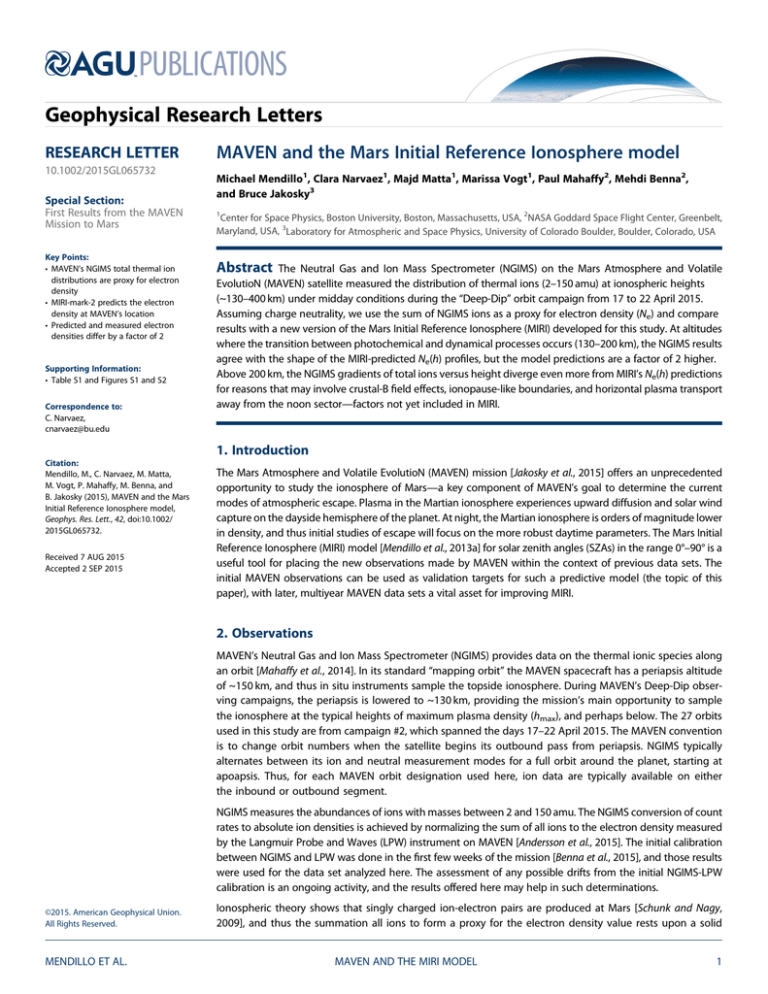
PUBLICATIONS
Geophysical Research Letters
RESEARCH LETTER
10.1002/2015GL065732
Special Section:
First Results from the MAVEN
Mission to Mars
Key Points:
• MAVEN’s NGIMS total thermal ion
distributions are proxy for electron
density
• MIRI-mark-2 predicts the electron
density at MAVEN’s location
• Predicted and measured electron
densities differ by a factor of 2
Supporting Information:
• Table S1 and Figures S1 and S2
Correspondence to:
C. Narvaez,
cnarvaez@bu.edu
MAVEN and the Mars Initial Reference Ionosphere model
Michael Mendillo1, Clara Narvaez1, Majd Matta1, Marissa Vogt1, Paul Mahaffy2, Mehdi Benna2,
and Bruce Jakosky3
1
Center for Space Physics, Boston University, Boston, Massachusetts, USA, 2NASA Goddard Space Flight Center, Greenbelt,
Maryland, USA, 3Laboratory for Atmospheric and Space Physics, University of Colorado Boulder, Boulder, Colorado, USA
Abstract
The Neutral Gas and Ion Mass Spectrometer (NGIMS) on the Mars Atmosphere and Volatile
EvolutioN (MAVEN) satellite measured the distribution of thermal ions (2–150 amu) at ionospheric heights
(~130–400 km) under midday conditions during the “Deep-Dip” orbit campaign from 17 to 22 April 2015.
Assuming charge neutrality, we use the sum of NGIMS ions as a proxy for electron density (Ne) and compare
results with a new version of the Mars Initial Reference Ionosphere (MIRI) developed for this study. At altitudes
where the transition between photochemical and dynamical processes occurs (130–200 km), the NGIMS results
agree with the shape of the MIRI-predicted Ne(h) profiles, but the model predictions are a factor of 2 higher.
Above 200 km, the NGIMS gradients of total ions versus height diverge even more from MIRI’s Ne(h) predictions
for reasons that may involve crustal-B field effects, ionopause-like boundaries, and horizontal plasma transport
away from the noon sector—factors not yet included in MIRI.
1. Introduction
Citation:
Mendillo, M., C. Narvaez, M. Matta,
M. Vogt, P. Mahaffy, M. Benna, and
B. Jakosky (2015), MAVEN and the Mars
Initial Reference Ionosphere model,
Geophys. Res. Lett., 42, doi:10.1002/
2015GL065732.
Received 7 AUG 2015
Accepted 2 SEP 2015
The Mars Atmosphere and Volatile EvolutioN (MAVEN) mission [Jakosky et al., 2015] offers an unprecedented
opportunity to study the ionosphere of Mars—a key component of MAVEN’s goal to determine the current
modes of atmospheric escape. Plasma in the Martian ionosphere experiences upward diffusion and solar wind
capture on the dayside hemisphere of the planet. At night, the Martian ionosphere is orders of magnitude lower
in density, and thus initial studies of escape will focus on the more robust daytime parameters. The Mars Initial
Reference Ionosphere (MIRI) model [Mendillo et al., 2013a] for solar zenith angles (SZAs) in the range 0°–90° is a
useful tool for placing the new observations made by MAVEN within the context of previous data sets. The
initial MAVEN observations can be used as validation targets for such a predictive model (the topic of this
paper), with later, multiyear MAVEN data sets a vital asset for improving MIRI.
2. Observations
MAVEN’s Neutral Gas and Ion Mass Spectrometer (NGIMS) provides data on the thermal ionic species along
an orbit [Mahaffy et al., 2014]. In its standard “mapping orbit” the MAVEN spacecraft has a periapsis altitude
of ~150 km, and thus in situ instruments sample the topside ionosphere. During MAVEN’s Deep-Dip observing campaigns, the periapsis is lowered to ~130 km, providing the mission’s main opportunity to sample
the ionosphere at the typical heights of maximum plasma density (hmax), and perhaps below. The 27 orbits
used in this study are from campaign #2, which spanned the days 17–22 April 2015. The MAVEN convention
is to change orbit numbers when the satellite begins its outbound pass from periapsis. NGIMS typically
alternates between its ion and neutral measurement modes for a full orbit around the planet, starting at
apoapsis. Thus, for each MAVEN orbit designation used here, ion data are typically available on either
the inbound or outbound segment.
NGIMS measures the abundances of ions with masses between 2 and 150 amu. The NGIMS conversion of count
rates to absolute ion densities is achieved by normalizing the sum of all ions to the electron density measured
by the Langmuir Probe and Waves (LPW) instrument on MAVEN [Andersson et al., 2015]. The initial calibration
between NGIMS and LPW was done in the first few weeks of the mission [Benna et al., 2015], and those results
were used for the data set analyzed here. The assessment of any possible drifts from the initial NGIMS-LPW
calibration is an ongoing activity, and the results offered here may help in such determinations.
©2015. American Geophysical Union.
All Rights Reserved.
MENDILLO ET AL.
Ionospheric theory shows that singly charged ion-electron pairs are produced at Mars [Schunk and Nagy,
2009], and thus the summation all ions to form a proxy for the electron density value rests upon a solid
MAVEN AND THE MIRI MODEL
1
Geophysical Research Letters
10.1002/2015GL065732
foundation. We interpolated the time steps for each species to obtain a uniform cadence of one data point
every 10 s. The measurement precision depends on the magnitudes of the ion densities. For the dominant
ion (O2+), the instrument precision is estimated to be 1–2% when [O2+] ≥ 5 × 104/cm3; 5–10% when
[O2+] ≈ 2 × 104/cm3, and ~15% when [O2+] is in the 103/cm3 domain. Added to these is a ~ ±15% systematic
error for the uncertainties of the LPW electron density data used for cross calibration. Finally, we confined our
study to daytime conditions (SZA <90°) when the satellite was below ~400 km. The satellite moves about
35 km between data points, mostly horizontal, with altitude changing by ~5 km.
3. Model
3.1. Background
The Mars Initial Reference Ionosphere (MIRI) model [Mendillo et al., 2013a] is a semiempirical model that
relates the maximum electron density (Nmax) in the Martian ionosphere to solar zenith angle (SZA) and solar
flux (FSun). It was developed using 112,718 observed Nmax values spanning the years 2005–2012 that were
parameterized into a semiempirical model using photochemical-equilibrium equations. The observational
peak densities were obtained by the active ionosphere sounding mode of the radar instrument (Mars
Advanced Radar for Subsurface and Ionosphere Sounding (MARSIS)) on board the European Space Agency
Mars Express mission [Gurnett et al., 2005]. Validations for MIRI-mark-1 were conducted using Nmax values
measured by both Viking landers and by radio occultation experiments on flyby and orbital missions at
Mars [Mendillo et al., 2013a, Table 1 and Figures 2–4]. MIRI agreed with the Viking data to within ±3% and
± 8–10% for radio occultation case studies.
The MIRI-mark-1 model for Nmax is of limited direct use for MAVEN simply because the in situ observations are
made throughout the topside ionosphere, i.e., not just at hmax (assumed to coincide with periapsis for
Deep-Dip Campaign #2). In addition, the observations are not in the vertical direction (but along an orbital
track) and therefore do not share a common SZA. This was not the case for earlier radio occultation experiments on various satellites at Mars. The radio occultation technique derives vertical Ne(h) profiles under
the assumption of uniform morphology over spatially confined regions (i.e., narrow ranges of latitudes and
longitudes). These yield electron density profiles but ones limited almost exclusively to near-sunrise and
near-sunset conditions at high latitudes (SZA > ~70°, latitude > ~60°). The only other type of Ne(h) profiles
available came from the in situ probes on the two Viking landers [Hanson et al., 1977] that provided
pre-MAVEN vertical profiles of ion densities (with their sum assumed to be the electron density). The
Viking observations occurred near 1400 LT with SZA ~ 45°.
MAVEN’s highly elliptical orbit provides a remarkably new diagnostic capability that samples a more global
range of daytime and nighttime ionospheric conditions. Yet MAVEN/NGIMS data present a significant challenge for modelers due to the extended horizontal space traversed by the satellite as its sensors sample a
few hundred kilometers of vertical ionospheric structure. There are three approaches that can be used (1)
run a global (3-D) theoretical model and sample its output along a MAVEN trajectory, (2) run 1-D theoretical model many times along a MAVEN trajectory and extract the electron density at the orbital heights
sampled as a function of latitude, longitude, and local time, and (3) modify the semiempirical MIRImark-1 model (parameterized for SZAs at hmax) to include altitudes above and below the height of maximum density—and then extract the local plasma density at varying heights and SZAs along the trajectory.
We decided to take option (3) to create a MIRI-mark-2 that could provide electron densities both above
and below hmax. Building upon existing techniques keyed to Nmax offered the shortest development
time and allowed for the most computer efficient way to make model Ne(h) results available on the
MIRI website.
3.2. Model Development
The extension of MIRI from a single output value (Nmax for a fixed SZA and FSun) to a full vertical profile, Ne
(h), can be achieved by determining the shape of the electron profile to be used for those conditions. At
altitudes below hmax, the expectation is one of full photochemical equilibrium. Yet MAVEN rarely, if ever,
gets below hmax, and thus the theoretical model needed is one that addresses, in a comprehensive fashion,
altitudes above ~170 km where plasma diffusion becomes an important process. The Matta et al. [2013]
model was selected for use because it includes plasma diffusion dependent upon both ion-neutral and
MENDILLO ET AL.
MAVEN AND THE MIRI MODEL
2
Geophysical Research Letters
10.1002/2015GL065732
ion-ion collisions, and a neutral atmosphere with hydrogen (H and H2) that
leads to a broad range of ion-neutral
chemistry (e.g., hydrogenated ions).
Such processes are highly relevant
to MAVEN data sets because most of
the observations by NGIMS and other
instruments sampling the ionosphere
will do so in the topside altitude range
~200–400 km.
3.3. Model Runs
Our goal for MIRI-mark-2 was to create a
family of ionospheric profiles for nine
bins of solar zenith angles (0°–10°,
10°–20° …, 80°–90°) that can be normalized by the Nmax value predicted
by MIRI-mark-1 for that day’s solar flux
condition. For MAVEN applications, the
resultant Ne(h) profiles can then be
sampled at satellite heights along an
orbital track where the NGIMS observations are made. For the simulations
using the Matta et al. [2013] model, we
selected neutral atmospheres at 37
latitudes (90°S to 90°N in 5° steps) from
the Mars Climate Data Base (http://
www-mars.lmd.jussieu.fr/mcd_python/)
for conditions of average solar flux
(F10.7 = 130 units at 1 AU = 56 units at
1.524 AU), no dust, Mars at spring equiFigure 1. (top) Illustration of MIRI’s use of theoretical electron density
nox (Ls = 0), and 1500 LT for stable dayprofiles to form normalized profile shapes ordered by solar zenith angles.
time conditions. A compatible solar
Validation of Ne(h) profiles generated by the BU Mars Ionosphere Model
appears in Mendillo et al. [2011] and Matta et al. [2015]. The < Ne(h) > profile irradiance model at Mars was derived
for each 10° bin of SZA comes from a different number of theoretical model from Earth-based measurements using
simulations. For the daytime bins shown, these were 4, 14, 24, 29, 47, 60, 76,
the Solar Irradiance Platform [Tobiska,
111, and 79 for a total of 444 profiles. The model-mean Ne(h) profiles shown
2004]. For the ionospheric calculation,
were calibrated by the MIRI-mark-1 daily values for Nmax (with their σ#1)
17 height levels were used between
predicted as function of SZA and solar flux, together with the uncertainties
80 and 400 km. At each of the 37 lati(σ#2) within each SZA bin from the theoretical profiles to yield the total
uncertainty in a MIRI-mark-2 prediction (see text). (bottom) Ne(h) profiles
tudes, a diurnal run was made to yield
using the α-Chapman layer formula for the < SZA > =5°–45° and hmax
a distribution of Ne(h) profiles versus
conditions shown in Figure 1 (top), and a neutral scale height (H) of 14 km.
local time. With 5° latitude resolution
and 1 h increments in local time, a total
of 888 Ne(h) profiles were available for characterization. We sorted them into the 10° SZA bins and computed
an average < Ne(h) > profile for each bin. This < Ne(h) > was then divided by that bin’s < Nmax > to obtain
the average profile shape to be calibrated by the MIRI-mark-1 prediction. Figure 1 shows the nine daytime
normalized profiles that, when calibrated by a daily Nmax versus SZA value from MIRI-mark-1, now comprise
the MIRI-mark-2 model. This paper deals with the first attempt at validation for MIRI-mark-2 using newly available MAVEN observations. Fortunately, solar flux conditions were stable during MAVEN’s 6 day Deep-Dip #2
campaign, thereby having one less source of variability to consider; the Deep-Dip orbits of April 2015 also had
excellent coverage at small SZAs—rarely found in previous missions. Additional MIRI validations of profile
shapes will be possible using pre-MAVEN radio occultation data closer to the solar terminator and from
MARSIS topside sounder observations under various SZA conditions.
MENDILLO ET AL.
MAVEN AND THE MIRI MODEL
3
Geophysical Research Letters
10.1002/2015GL065732
Figure 2. Comparison of MAVEN/NGIMS observations with MIRI predictions for orbit #1060 on 17 April 2015. (middle) Orbit
segment coordinates when the satellite was below 400 km. (left) NGIMS total ion densities (black squares) in comparison to
MIRI electron density values. The outbound portion of the orbit did not have NGIMS observations of ions but rather of
neutrals (see text).
To estimate the uncertainty values associated with MIRI-mark-2 predictions, we considered two sources of
model variability. First is the variability associated with the profile’s normalization by Nmax (σ#1 from
MIRI-mark-1). As described in Mendillo et al. [2013a], this could be characterized using the magnitudes of
Nmax, and σ#1 ranged from 5% (midday Nmax) to 30% (near-terminator Nmax). For the MAVEN data set used
here (low SZAs and therefore large Nmax values), the calibration uncertainty was ±5%. A second source of
variability comes from the standard deviations (σ#2) at each altitude in each bin of the averaged theoretical
profiles. These were about half the values of σ#1 for the small range of SZAs used and were treated as
independent contributors to the overall uncertainty. MIRI-mark-2 results shown below will include total
uncertainty estimates as shadings about the predicted curves.
The attention to model variability is driven by the fact that the Martian ionosphere (and in particular its
topside structure) is not always in full photochemical equilibrium (e.g., as portrayed by Chapman Theory
profiles) throughout a diurnal simulation. If that were the case, all of the Ne(h) patterns for a given SZA
and neutral atmosphere would be identical. There are several reasons why this is not the case for the
theoretical profiles computed for MIRI. Most important, the inclusion of a sophisticated treatment of
plasma diffusion leads to the same zenith angle having different topside profile shapes. Thus, it matters
if a specific SZA (e.g., 35°) occurs after sunrise or prior to sunset at the subsolar latitude or at local noon
from a higher latitude. There are also latitude differences in the background neutral atmosphere that
lead to different Ne(h) profile shapes for the same SZA. Figure 1 (bottom) gives Chapman shapes for
the SZA and height ranges encountered during Deep-Dip #2 campaign—clearly inadequate for topside
ionosphere studies.
4. Data-Model Comparisons
In the course of the 6 day MAVEN Deep-Dip campaign in April 2015, the orbits were essentially fixed in
space, with the planet rotating below. This results in a fairly consistent pattern of height, latitude, and local
time (and thus SZA) along the trajectory segments below 400 km. Longitudes, of course, change with each
satellite pass.
Figure 2 shows how we relate the MAVEN orbit to the observations as a function of SZA and height below
400 km. In Figure 2 (middle), a sample Deep-Dip pass on 17 April 2015 is shown with the latitudes, longitudes, and local times of the NGIMS observational start and end times noted. The NGIMS sampling of
vertical structure along the outbound orbit segment (#1060, red) was for neutrals and thus Figure 2 (right)
does not show ion data; the subsequent inbound orbit segment (#1060, blue) occurred ~ 4 h later, and
MENDILLO ET AL.
MAVEN AND THE MIRI MODEL
4
Geophysical Research Letters
10.1002/2015GL065732
Figure 3. Same format as Figure 2 but using continuous orbit segments (#1080 inbound and #1081 outbound) from 21
April 2015. The steep topside gradients suggestive of ionopause-like boundaries near 240 km are not included in MIRI
predictions (see text).
NGIMS was then in ion mode. Note that the observations below 400 km in each segment were acquired
over a short orbital time (~10 min). These brief samples encompass broad spatial portions of each hemisphere and significant SZA changes (0°–50°), yet within a narrow band of local times; this is typical of all
passes (see Figures 3 and 4).
In Figure 2 (left), the NGIMS total ion densities are indicated by the solid squares. The solid colored line in each
panel gives the MIRI-mark-2 predicted Ne value, and the shading gives the MIRI uncertainties (typically 5–6%).
There are several things to note in this first comparison of NGIMS and MIRI values: (1) the model values are all
higher than the data, (2) considerable topside variability in total ion density, and (3) the gradient with altitude
above ~240 km diverges markedly from model predictions.
Figure 4. Same format as Figures 2 and 3 but for the total NGIMS data set in comparison to MIRI’s average of all predictions
(with standard deviation) for the period 17–22 April 2015. Different symbols and colors are used to indicate the seven
NGIMS data sets showing ionopause-like topside gradients (purple triangles), the nine NGIMS data sets obtained above
regions of strong crustal-B fields in the southern hemisphere (green circles), and the three NGIMS ionopause cases above
crustal-B regions (orange asterisks). The remaining eight NGIMS profiles without ionopauses and not above strong crustal B
(e.g., the one shown in Figure 2) are shown as black squares. Average patterns are given in the supporting information.
MENDILLO ET AL.
MAVEN AND THE MIRI MODEL
5
Geophysical Research Letters
10.1002/2015GL065732
Figure 3 presents observations from 21 April 2015, in the same format as Figure 2, to illustrate a more
dramatic case of item (3)—a significant difference in the topside structure between data and model. Here
we show continuous orbit segments: for the inbound trajectory of orbit #1080 (Figure 3, left), there is a steep
altitude gradient to Ne ~2 × 103 e /cm3 near 240 km, with irregular recovery and decrease to ~10 3 e /cm3
above. This is followed (Figure 3, right) by another steep gradient above ~240 km on the outbound segment
of orbit #1081. Taken together, these suggest “ionopause-like” behavior for the 11:00–12:30 local time sector.
Abrupt terminations of the Martian dayside ionosphere due to solar wind interactions have been described in
Nagy et al. [2004] and Duru et al. [2009]. Detections of such “ionopause” signatures using MAVEN data are
described by Vogt et al. [2015]. Of the 27 orbit segments examined, 10 had patterns of ionopause-like structures not included in MIRI predictions. We examined the longitudes of these orbit segments at latitudes in the
southern hemisphere to see if they coincided with areas of strong crustal magnetic fields, i.e., if they occurred
in the longitude range 130°–260° east [Withers et al., 2005; Mendillo et al., 2011, 2013b]. Of the 13 orbit
segments within crustal-B longitudes, only three of the 10 ionopause-like patterns occurred there.
Figure 4 summarizes the total NGIMS data set in comparison to the MIRI-mark-2 predictions. In the central panel,
all 27 orbit segments from MAVEN’s second Deep-Dip campaign are shown. There are clearly consistent patterns
of heights and SZAs sampled during the inbound and outbound orbit segments of this 6 day period. The
MIRI-predicted electron densities for each type of orbit segment (inbound and outbound) were averaged, and
those mean Ne values are shown (with their small variabilities) in Figure 4 (right and left). The total number of
NGIMS data points, sorted by height and SZA, is given using symbols and color coding to indicate the subsets
of observations showing ionopause-like gradients and smoother topside patterns near and away from strong
crustal-B fields. There is more variability with the green points (above crustal B), but their mean values (shown
in Figure S1 of the supporting information) are essentially the same as obtained with the less-variable black points
(away from crustal B). The topside gradients showing ionopause-like characteristics above and away from crustalB locations (orange asterisks and purple triangles, respectively) are similarly consistent and show the greatest
departures from MIRI predictions (see supporting information). An overall summary of observations, together with
MIRI input/output values at hmax (assumed to be periapsis), appears in Table S1 of the supporting information.
5. Interpretation and Conclusions
We have used the MAVEN Deep-Dip campaign of 17–22 April 2015 to compare the total ion density from the
NGIMS sensor with the electron density patterns predicted by a new version of the Mars Initial Reference
Ionosphere (MIRI) model. The observations do not give vertical profiles, but rather provide data that span
the 130–400 km altitude range while traversing broad horizontal distances in both hemispheres (~36°
latitude and ~10° longitude, corresponding to ~2200 km and 610 km, respectively, near the equator), SZA
conditions varying between 0° and 50°. The MIRI-mark-2 model—developed to cope with such data sets
by using theoretical Ne(h) profile shapes calibrated by daily solar flux, Nmax, and SZA conditions—resulted
in the following set of preliminary conclusions:
1. At all ionospheric heights treated, the NGIMS data are consistently lower in magnitude than the MIRI predictions. In the altitude range where the transition occurs between photochemical-only processes and
plasma diffusion conditions (130–200 km), the morphology patterns between data and model are fairly
consistent (while differing by a factor of 2 in absolute magnitudes). This difference might be due to calibration uncertainties for these initial NGIMS data sets, and thus altitude gradient comparisons constitute
success criteria. As such, the visual agreement of Ne(h) gradients above hmax is encouraging for this first
test of a semiempirical ionospheric model with MAVEN’s observed plasma densities at Mars.
2. At altitudes above ~200 km, the NGIMS values of total ion density versus height diverge considerably from
the MIRI Ne(h) predictions derived only for photochemistry and vertical diffusion processes. In some cases,
differences may be due to horizontal transport away from the noon sector not included in the semiempirical MIRI model. Moreover, MIRI does not yet treat a high-altitude cutoff associated with “ionopause”
conditions, and it appears that NGIMS detected many such patterns [Vogt et al., 2015].
3. MIRI predictions do not yet take into consideration electron density deviations associated with crustal-B
fields at latitudes in the southern hemisphere in the longitude sector 130° to 260° E. A total of 13 orbit segments occurred above crustal-B regions, and only 3 of the 10 detected ionopause-like gradients occurred
in their vicinity.
MENDILLO ET AL.
MAVEN AND THE MIRI MODEL
6
Geophysical Research Letters
10.1002/2015GL065732
This preliminary analysis of MAVEN’s Deep-Dip Campaign #2 focused on initial comparisons between in situ
observations of total ion density by the NGIMS instrument and the latest version of MIRI for electron density.
The results obtained point to the contributions MAVEN observations will make to modeling efforts, initially as
validation targets (as shown here) and later as data inserted into the model to improve semiempirical predictions. The initial MAVEN/NGIMS observations from the single Deep-Dip orbit campaign used in this study
represent an extraordinary set of new results (recalling that only two VIKING observations of ion composition
existed prior to these observations). Additional data sets and semiempirical model development (how to
include effects caused by horizontal transport and crustal-B fields) will further MAVEN’s exploration of the
Martian ionosphere and its key relationships to atmospheric escape.
Acknowledgments
We are grateful for the assistance of the
NGIMS team for making the Deep-Dip
data from Campaign #2 available in
such a timely fashion. We thank, in
particular, Meredith Elrod. This work was
supported, in part, by NASA/MAVEN
Participating Scientist grants NNX13AO20G and NNX-13AO35G at Boston
University, and to MAVEN subcontract
1000320450 from the University of
Colorado to Boston University. At the
NASA Goddard Space Flight Center, the
NGIMS program is supported by its
MAVEN mission contract. The NGIMS
data can be found at the PDS: Planetary
Atmospheres Data Node. Website: http://
atmos.nmsu.edu/PDS/data/PDS4/
MAVEN/.
The Editor thanks two anonymous
reviewers for their assistance in
evaluating this paper.
MENDILLO ET AL.
References
Andersson, L., R. E. Ergun, G. T. Delory, A. I. Eriksson, J. Westfall, H. Reed, J. McCauly, D. Summers, and D. Meyers (2015), The Langmuir Probe
and Waves instrument for MAVEN, Space Sci. Rev., doi:10.1007/s11214-015-0194-3, in press.
Benna, M., P. R. Mahaffy, J. M. Grebowsky, J. M. Plane, R. V. Yelle, and B. M. Jakosky (2015), Metallic ions in the upper atmosphere of Mars from
the passage of comet C/2013 A1 (Siding Spring), Geophys. Res. Lett., 42, 4670–4675, doi:10.1002/2015GL064159.
Duru, F., D. A. Gurnett, R. A. Frahm, J. D. Winningham, D. D. Morgan, and G. G. Howes (2009), Steep, transient density gradients in the Martian
ionosphere similar to the ionopause at Venus, J. Geophys. Res., 114, A12310, doi:10.1029/2009JA014711.
Gurnett, D., et al. (2005), Radar sounding of the ionosphere of Mars, Science, 310, 1929–1933, doi:10.1126/science.1121868.
Hanson, W., S. Sanatani, and D. Zuccaro (1977), The Martian ionosphere as observed by the Viking retarding potential analyzers, J. Geophys.
Res., 82, 4351–4363, doi:10.1029/JS082i028p04352.
Jakosky, B., et al. (2015), The Mars atmosphere and volatile evolution (MAVEN) mission, Space Sci. Rev., doi:10.1007/s11214-015-0139-x.
Mahaffy, P., et al. (2014), The neutral gas and ion mass spectrometer on the Mars atmosphere and volatile evolution mission, Space Sci. Rev.,
doi:10.1007/s11214-014-0091-1.
Matta, M., P. Withers, and M. Mendillo (2013), The composition of Mars’ topside ionosphere: Effects of hydrogen, J. Geophys. Res. Space
Physics, 118, 1–13, doi:10.1002/jgra.50104.
Matta, M., M. Mendillo, P. Withers, and D. Morgan (2015), Interpreting Mars ionospheric anomalies over crustal magnetic field regions using a
2-D ionospheric model, J. Geophys. Res. Space Physics, 120, 766–777, doi:10.1002/2014JA020721.
Mendillo, M., A. Lollo, P. Withers, M. Patzold, and S. Tellmann (2011), Modeling Mars’ ionosphere with constraints from same-day observations by
Mars Global Surveyor and Mars Express, J. Geophys. Res., 116, A11303, doi:10.1029/2011JA016865.
Mendillo, M., A. Marusiak, P. Withers, D. Morgan, and D. Gurnett (2013a), A new semiempirical model of the peak electron density of the
Martian ionosphere, Geophys. Res. Lett., 40, 5361–5365, doi:10.1002/2013GL057631.
Mendillo, M., C. Narvaez, P. Withers, M. Matta, W. Kofman, and J. Mouginot (2013b), Variability of ionospheric total electron content at Mars,
Planet. Space Sci., 86, 117–129, doi:10.1016/j.pss.2013.08.010.
Nagy, A. F., et al. (2004), The plasma environment of Mars, Space Sci. Rev., 111, 33–114, doi:10.1023/B:SPAC.0000032718.47512.92.
Schunk, R. W., and A. F. Nagy (2009), Ionospheres: Physics, Plasma Physics, and Chemistry, 2nd ed., Cambridge Univ. Press, New York.
Tobiska, W. K. (2004), SOLAR2000 irradiances for climate change, aeronomy, and space systems engineering, Adv. Space Res., 34, 1736–1746.
Vogt, M. F., P. Withers, P. R. Mahaffy, M. Benna, M. K. Elrod, J. S. Halekas, J. E. P. Connerney, J. R. Espley, D. L. Mitchell, and B. M. Jakosky (2015),
Ionopause-like density gradients in the Martian ionosphere: A first look with MAVEN, Geophys. Res. Lett., 42, doi:10.1002/2015GL065269.
Withers, P., M. Mendillo, H. Rishbeth, D. Hinson, and J. Arkani-Hamed (2005), Ionospheric characteristics above Martian crustal magnetic
anomalies, Geophys. Res. Lett., 32, L16204, doi:10.1029/2005GL023483.
MAVEN AND THE MIRI MODEL
7

